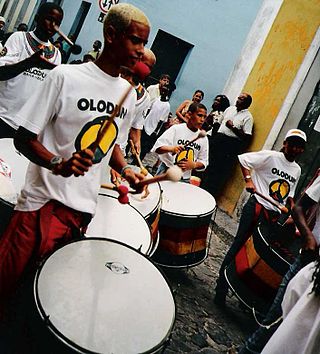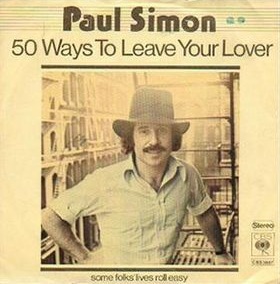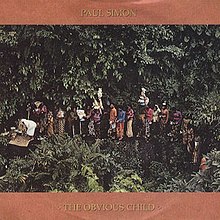
The Rhythm of the Saints is the eighth solo studio album by American singer-songwriter Paul Simon, released on October 16, 1990, on Warner Bros. In much the same way that Simon's previous album, Graceland, released in 1986, drew upon South African music, this album was inspired by Brazilian musical traditions. Like its predecessor, the album was commercially successful and received mostly favorable reviews from critics.

Olodum is a bloco-afro from Salvador's carnival, in Bahia, Brazil. It was founded by the percussionist Neguinho do Samba.

"Knockin' on Heaven's Door" is a song by American singer-songwriter Bob Dylan, written for the soundtrack of the 1973 film Pat Garrett and Billy the Kid. Released as a single two months after the film's premiere, it became a worldwide hit, reaching the Top 10 in several countries. The song became one of Dylan's most popular and most covered post-1960s compositions, spawning covers from Eric Clapton, Guns N' Roses, Randy Crawford, and more.
Mae Moore is a Canadian singer-songwriter. Her music is a blend of pop, folk and jazz. Her most successful album, 1992's Bohemia, was an international hit, although her other albums have been successful mainly in Canada. Over the course of her career, Moore achieved nine top 40 singles in Canada, as well as two JUNO nominations, two Canadian Folk Music Awards nominations, and won two SOCAN Awards. Moore's second album, Bohemia, drew critical acclaim and was released internationally. Her biggest hit, "Genuine", became a top 10 hit in June 1995 and was one of Canada's ten most-performed compositions of the year.

"All Right Now" is a song by English rock band Free, released on their third studio album, Fire and Water (1970). It was released by Island Records, a record label founded by Chris Blackwell. Released as the album's second single, "All Right Now" peaked at number two on the UK Singles Chart and number four on the US Billboard Hot 100 singles chart. In July 1973, the song was re-released, peaking at number 15 on the UK chart. In 1991, a Bob Clearmountain remix of the song was released, reaching number eight on the UK chart.

"50 Ways to Leave Your Lover" is a song by the American singer-songwriter Paul Simon. It was the second single from his fourth studio album, Still Crazy After All These Years (1975), released on Columbia Records. Backing vocals on the single were performed by Patti Austin, Valerie Simpson, and Phoebe Snow. The song features a recognizable repeated drum riff performed by drummer Steve Gadd.

"Mother and Child Reunion" is a song by the American singer-songwriter Paul Simon. It was the lead single from his second studio album, Paul Simon (1972), released on Columbia Records. The song reached No. 4 on the Billboard Hot 100 chart in March 1972.

"You Can Call Me Al" is a song by American singer-songwriter Paul Simon. It was the lead single from his seventh studio album, Graceland (1986), released on Warner Bros. Records. Written by Simon, its lyrics follow an individual seemingly experiencing a midlife crisis. Its lyrics were partially inspired by Simon's trip to South Africa and experience with its culture. Released in August 1986, "You Can Call Me Al" became one of Simon's biggest solo hits, reaching the top five in seven countries.

"I've Been Thinking About You" is a song by British-American band Londonbeat, released as the lead single from their second studio album, In the Blood (1990). The song was produced by Martyn Phillips, and written by band members Jimmy Chambers, George Chandler, Jimmy Helms, and William Henshall. It became a major worldwide hit, reaching the number-one spot in more than 10 countries—including Australia, Canada, Germany and the United States—and peaking at number two on the UK Singles Chart.

"Kodachrome" is a song by the American singer-songwriter Paul Simon. It was the lead single from his third studio album, There Goes Rhymin' Simon (1973), released on Columbia Records. The song is named after Kodak's now-discontinued reversal film brand Kodachrome.

"Two Hearts" is a song by Phil Collins from the soundtrack to the film Buster (1988), in which Collins played the lead role. The song was written and produced by Collins and Lamont Dozier. It reached number one in the United States and Canada in January 1989. It features in the end credits.

"Graceland" is the title song of the album Graceland, released in 1986 by Paul Simon. The song features vocals by The Everly Brothers. The lyrics follow the singer's thoughts during a road trip to Graceland after the failure of his marriage. Actress and author Carrie Fisher, Simon's ex-wife, said that the song referred in part to their relationship.

"Cecilia" is a song by American musical duo Simon & Garfunkel. It was released in April 1970 as the third single from the duo's fifth and final studio album, Bridge over Troubled Water (1970). Written by Paul Simon, the song's origins lie in a late-night party, in which the duo and friends began banging on a piano bench. They recorded the sound with a tape recorder, employing reverb and matching the rhythm created by the machine. Simon later wrote the song's guitar line and lyrics on the subject of an untrustworthy lover.

"It's Probably Me" is a song originally released in 1992 as a collaboration by Sting featuring Eric Clapton, Michael Kamen, and David Sanborn. Released from the soundtrack to the action comedy film Lethal Weapon 3 in June 1992, the song reached number 20 on the US Billboard Album Rock Tracks chart and number 12 on Canada's RPM 100 Hit Tracks chart. It was more successful in Europe, peaking at number one in Italy, number four in France, and number six in the Netherlands.

"Loves Me Like a Rock" is a song by the American singer-songwriter Paul Simon. It was the second single from his third studio album, There Goes Rhymin' Simon (1973), released on Columbia Records. It features background vocals from the Dixie Hummingbirds, a Southern black gospel group. Although the lyrics are not typically associated with gospel music, the Dixie Hummingbirds were eager to record the song with Simon, and they recorded their own version soon after for their 1973 album We Love You Like a Rock/Every Day and Every Hour.

"Woman in Chains" is a song by English band Tears for Fears, released as the second single from their third studio album, The Seeds of Love (1989). It has been described as a "feminist anthem". It was an international success, reaching the top 40 in several countries, including the United Kingdom, the United States, Canada, France, and the Netherlands.

"Love Is in the Air" is a 1977 disco song by Australian singer John Paul Young. It was written by George Young and Harry Vanda, and released as the lead single from Young's fourth studio album, Love Is in the Air (1978). The song became a worldwide hit in 1978, peaking at No. 3 on the Australian charts and No. 5 on the UK Singles Chart. In the United States, it peaked at No. 7 on the pop chart and spent two weeks at No. 1 on the Adult Contemporary chart, his only U.S. top 40 hit. The song plays at 122 beats per minute, a typical 1970s disco rhythm. At the Australian 1978 King of Pop Awards, the song won Most Popular Australian Single. In 1992, a remix of the song was released and featured on the soundtrack to the Golden Globe-nominated film Strictly Ballroom. A new music video was also produced.

"Late in the Evening" is a song by American singer-songwriter Paul Simon. It was the lead single from his fifth studio album, One-Trick Pony (1980), released on Warner Bros. Records.

"Let's Stick Together" is a blues-based rhythm and blues song written by Wilbert Harrison. In 1962, Fury Records released it as a single. Harrison further developed the song and in 1969, Sue Records issued it as a two-part single titled "Let's Work Together". Although Harrison's original song did not appear in the record charts, his reworked version entered the U.S. Top 40.

"The Boy in the Bubble" is a song by the American singer-songwriter Paul Simon. It was the third single from his seventh studio album, Graceland (1986), released on Warner Bros. Records. Written by Simon and Forere Motloheloa, its lyrics explore starvation and terrorism, juxtaposed with wit and optimism.



















